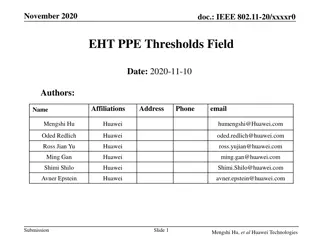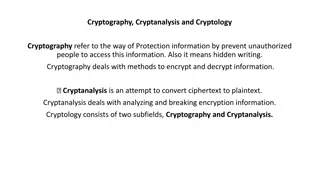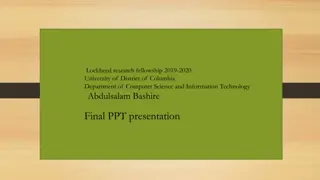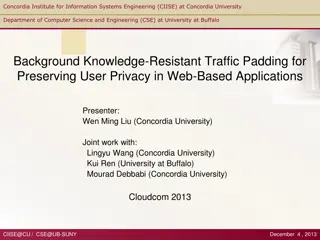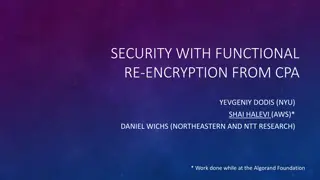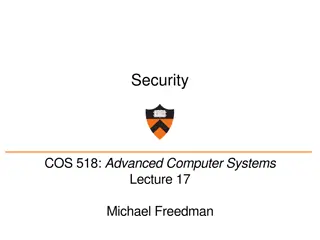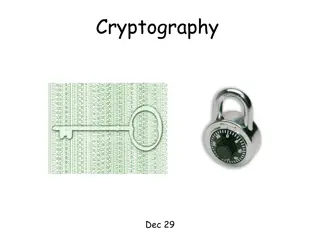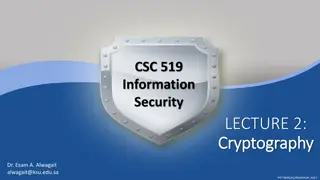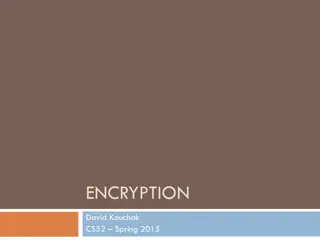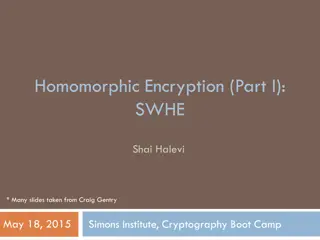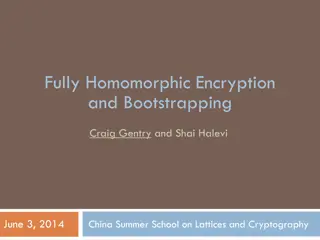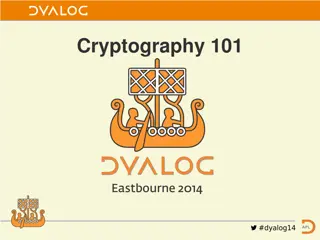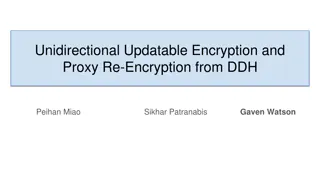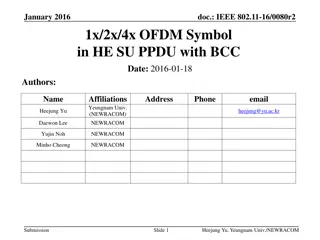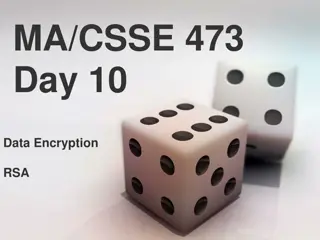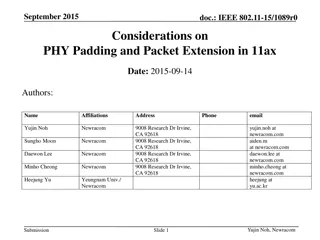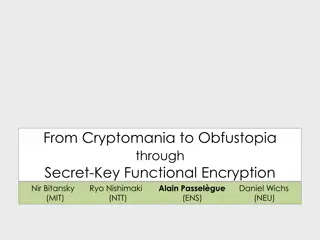Understanding Cryptography: Basics of Encryption and Padding
Cryptography is essential for secure communication between parties, ensuring confidentiality and integrity of data. This overview covers basic math concepts, block ciphers, encryption modes like ECB and CBC, and the importance of padding in securing plaintext data.
Download Presentation

Please find below an Image/Link to download the presentation.
The content on the website is provided AS IS for your information and personal use only. It may not be sold, licensed, or shared on other websites without obtaining consent from the author. Download presentation by click this link. If you encounter any issues during the download, it is possible that the publisher has removed the file from their server.
E N D
Presentation Transcript
To get a head start, please go here!: http://130.207.1.252/ Padding Oracle Attacks GREYHAT 11/03/16 SIDDARTH SENTHILKUMAR
Overview 1) Basic Math 2) Block Ciphers 3) Padding & Padding Oracles 4) Demo 5) Real World Examples
Demo Step 0 Follow instructions here: http://130.207.1.252/
What is Cryptography How to send information securely from one party to another securely It should be Hard to crack the original message without the key Ciphertext, plaintext, key
1) Basic Math On computer, all information is stored as bits. Encrypting bits == Encrypting message Important Property: K P K = P Think of the first XOR as encrypting, second XOR as decrypting. K P = C C K = P Example: K = 68, P = 90 68 90 = 1000100 1011010 = 0011110 = 30 30 68 = 0011110 1000100 = 1011010 = 68
2) Block Ciphers Symmetric Encryption Take a plaintext block of bits, encrypt it using key. Take a ciphertext block of bits, decrypt it using the key. Examples: AES, DES, Blowfish, RC5 Have Modes of Operation
ECB Mode ECB Electronic Codebook Mode. Take a block of plaintext, encrypt, repeat. Insecure. Identical plaintexts map to identical ciphertexts! Crack with frequency analysis
CBC Mode Cipher Block Chaining Use output of one encryption as input for the next. Ensures each block will have different output, even if each block has same plaintext. ENCRYPTION DECRYPTION
3) Padding Assume a block size of 16 bytes. Let s say the plaintext completely fills a bunch of blocks until the last block, where it only fills 10 bytes. Still need 16 bytes in that last block! Need to pad plaintext somehow. Carefully chosen pad application needs to distinguish plaintext bytes from pad bytes
Padding (Contd) Most common PKCS#7 The value of each added byte is the number of bytes that are added, i.e. N bytes, each of value N are added. Ex. Let s say there are 5 bytes remaining in an 8 byte block for which we are creating a pad. [a8 b3 44 05 05 05 05 05] What if we don t need a pad? [a8 b3 44 42 13 09 c12 31] [08 08 08 08 08 08 08 08] If it had been a 16 byte block, would have looked like [ ..][10 10 10 10 10 10 10 10 10 10 10 10 10 10 10 10]
Padding Oracle Oracle something from the Matrix that tells you your future Padding Oracle something that tells you whether a given block has valid padding or not So, let s say I have a ciphertext block that I submit to a server Server decrypts it using its private key, and has a plaintext It checks is this padding valid aka repeating number of bytes padded If yes, tells you your pad was valid . If no, tells you your pad was not valid
C1 C1 B-But How? C2 P2 We are going to make our own version of C1, call it C1 . We submit C1 + C2 to the server. The server will tell us This was a valid pad! We use C1 , C1, and C2 to get P2.
Where does our attack begin? C1 C1 Some properties of Intermediate Stage: 1) P2 = I2 2) I2 = P2 C1 C1 We make a C1 -> Bytes [1, 15] are junk -> Byte [16] = 00 C1 I2 = P2 P2 P2 While server says Padding NOT OK : Try C1 [16] = 01, 02, , FF I2 = C1 P2' I2[16] = C1'[16] P2'[16] When server says PADDING OK -> P2 [16] must have been 01 P2[16] = C1[16] I2[16]
How to get the other bytes before? We aim to get a pad of 02 02 decrypted by the server Goal: P2 = [ __________________________ 02 02] Currently, we know I2[16]. Let s make a C1 so that P2 [16] becomes 02 C1 [16] = P2 [16] I2[16] C1 [16] = 02 I2[16] We now have a byte C1 [16] so that P2 [16] will be 02 Let C1 = [ _______________ 00 XX] <- XX is C1 [16] I2 = [ ____________________ ] -------------------------------------------------------- P2 = [ ________________?? 02] Increment 00 in C1 until the ?? In P2 is 02. When that happens, server will respond PADDING OK! I2 = C1 P2' I2[15] = C1'[15] P2'[15] P2[15] = C1[15] I2[15]
C1 Review C2 P2 We are going to make our own version of C1, call it C1 . We submit C1 + C2 to the server. The server will tell us This was a valid pad! We use C1 , C1, and C2 to get P2.
That was all for decrypting a single block. What about the rest? Now, just repeat the process for every single block in the message! Exception: The very first block If the IV is a secret, then we don t know the C1 for the first block, so can t use padding oracle against it. At any rate, this isn t a big deal Hopefully the first block is something like Dear Aunt Sally anyway
Analysis Essentially, for each byte of the C1 , we check all 256 values to figure out which one results in a valid pad. How many queries does it take to crack a message? = 256 queries/byte * 16 bytes / block * n blocks / message = 4096n queries/message Let s say there are 1000 blocks in your message (1000 * 16 bytes = 16KB) 4096 * 1000 = 4 096 000 queries / message If each query takes 1ms, that s about 4 096 000 ms, or ~68 minutes On average, we only need to make half those queries ~34 minutes to crack a message
Demo http://crypto.chal.csaw.io:8001/
Have Padding Oracle Attacks Happened in Real Life? Yes!!
References/Questions? http://robertheaton.com/2013/07/29/padding-oracle-attack/



